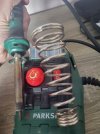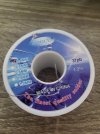[ SOLVED ] Yamaha A-S700 intermittent power-on failure. Updated as of 16 March 2024
Please help in repairing my Yamaha A-S700
Over recent time my A-S700 has developed an intermittent fault (and today eventually failed completely).
It started a week ago, it would not switch on. I tried on/off several times, it didn't help. I then unplugged/plugged the cable and it switched on. I concluded it was a lost connection somewhere in power plug either in the unit side or wall socket side, and forgot about it.
Then, a couple of days ago the situation repeated. I again unplugged/plugged physically the cord several times, eventually the amp switched on. I thought that it was a loose power socket on the unit itself, but I tried different cables and all for sure the connection is perfect.
So this situation repeated several time, getting worser each time, with longer time it needed to stay disconnected - but the amp did eventually power on each time before today.
Eventually today I cannot switch it on at all.
Googling helped me find exactly the same symptoms, albeit for other Yamaha models. Several people in that thread confirmed that the reason for the fault was the same dodgy capacitor and several confirmed they successfully fixed it: https://www.avforums.com/threads/yamaha-dsp-ax861se-intermittent-power-on.2247151/
I do not have skills with serious electronics (which I do regret), I can do basic soldering and was do tinker sometimes with nodemcu and home automation
But I naively thought I would use the diagrams in the A-S700 Service Manual (I found online) and find the damn capacitor
Very quickly I realised, though, there is no miracle, and I just do not have the advanced knowledge required to fix it all by myself.
Although I am realtively new here, I've been reading asr extensively, and I know there are many skilled people here who can help!
I am sure that the symptoms I described (and the same symptoms described in the above avforum link), definitely ring the bell for whose with knowledge!
Thank you!
Please help in repairing my Yamaha A-S700
Over recent time my A-S700 has developed an intermittent fault (and today eventually failed completely).
It started a week ago, it would not switch on. I tried on/off several times, it didn't help. I then unplugged/plugged the cable and it switched on. I concluded it was a lost connection somewhere in power plug either in the unit side or wall socket side, and forgot about it.
Then, a couple of days ago the situation repeated. I again unplugged/plugged physically the cord several times, eventually the amp switched on. I thought that it was a loose power socket on the unit itself, but I tried different cables and all for sure the connection is perfect.
So this situation repeated several time, getting worser each time, with longer time it needed to stay disconnected - but the amp did eventually power on each time before today.
Eventually today I cannot switch it on at all.
Googling helped me find exactly the same symptoms, albeit for other Yamaha models. Several people in that thread confirmed that the reason for the fault was the same dodgy capacitor and several confirmed they successfully fixed it: https://www.avforums.com/threads/yamaha-dsp-ax861se-intermittent-power-on.2247151/
I do not have skills with serious electronics (which I do regret), I can do basic soldering and was do tinker sometimes with nodemcu and home automation
But I naively thought I would use the diagrams in the A-S700 Service Manual (I found online) and find the damn capacitor
Very quickly I realised, though, there is no miracle, and I just do not have the advanced knowledge required to fix it all by myself.
Although I am realtively new here, I've been reading asr extensively, and I know there are many skilled people here who can help!
I am sure that the symptoms I described (and the same symptoms described in the above avforum link), definitely ring the bell for whose with knowledge!
Thank you!
Last edited by a moderator:



